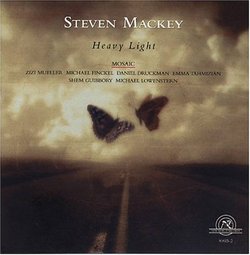| All Artists: Finckel, Tahmizian, Druckman, Steven Mackey, Mosaic Title: Heavy Light Members Wishing: 2 Total Copies: 0 Label: New World Records Original Release Date: 7/1/2004 Release Date: 7/1/2004 Genre: Classical Styles: Chamber Music, Forms & Genres, Concertos, Historical Periods, Classical (c.1770-1830) Number of Discs: 1 SwapaCD Credits: 1 UPC: 093228061526 |
Search - Finckel, Tahmizian, Druckman :: Heavy Light
 | Finckel, Tahmizian, Druckman Heavy Light Genre: Classical
Steven Mackey (b. 1956) characterizes his music as "?weird but with a sense of humor, bright, colorful but slightly twisted ? The material in my music?the tunes, chords, and textures?tend to explore fringe modes of conscio... more » |
Larger Image |
CD Details
Synopsis
Album Description
Steven Mackey (b. 1956) characterizes his music as "?weird but with a sense of humor, bright, colorful but slightly twisted ? The material in my music?the tunes, chords, and textures?tend to explore fringe modes of consciousness rather than brand-name emotion or logical thought. Generally speaking, these fringe modes are alert and lucid as opposed to trance-like. Often it is the unlikely combination of otherwise simple elements that transcends and confounds familiar patterns?. It is an omnivorous music that represents free speech, liberal democracy with an adventurous spirit that unflinchingly embraces all of life?s experiences. And it doesn?t sound like anything else." Heavy Light (2001) started life as a collaborative venture with choreographer Donald Byrd and the ensemble MOSAIC. The music and dance grew up together as an exploration of a psychedelic aesthetic. To me that meant a music that was more about stream of consciousness than logical development, that was more evocative than dramatic, that would exist in a world where time, space and gravity were slightly warped. Heavy Light begins with a long section that is, at its core, a slowly building ritual percussion solo. The middle of the piece is made up of a series of miniatures including a pre-recorded tape of computer-processed voices separated by electric guitar drones. The final ten minutes is a guitar solo based on the drones and a raga-like melody. Micro-Concerto (1999) attempts to imagine particular ways to coax sound out of pieces of wood, metal and skin instead of simply hitting things. In addition to providing a virtuoso "vehicle" for the percussionist, Micro-Concerto also explores a variety of more complex roles that the individual can play in relation to the ensemble. Indigenous Instruments (1989 is vernacular music from a culture that doesn?t actually exist. I fantasized about a culture and their uses for music, did thought experiments to invent the kind of instruments they might play, and wrote "folk melodies" idiomatic to those instruments. The exercise was silly but did in fact succeed in leading me to sounds and textures that I would never have thought of in my mode as a serious concert-music composer. My starting point was to re-tune or de-tune the ensemble; the cello has a radical microtonal scordatura, the violin?s G string is tuned down an octave and a quarter tone, the flute is pulled out a quarter-tone flat, and one note of the piano is prepared. ?Steven Mackey

 Track Listings (14) - Disc #1
Track Listings (14) - Disc #1